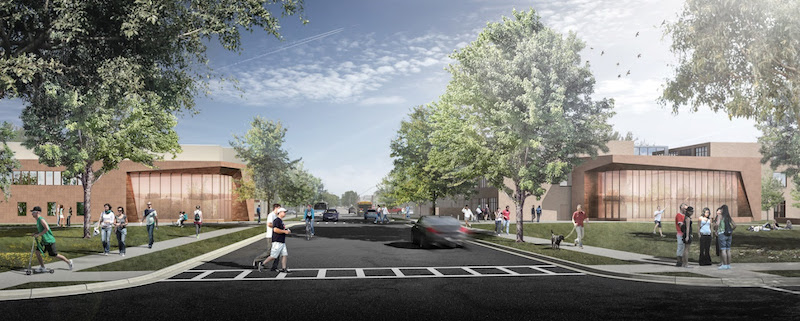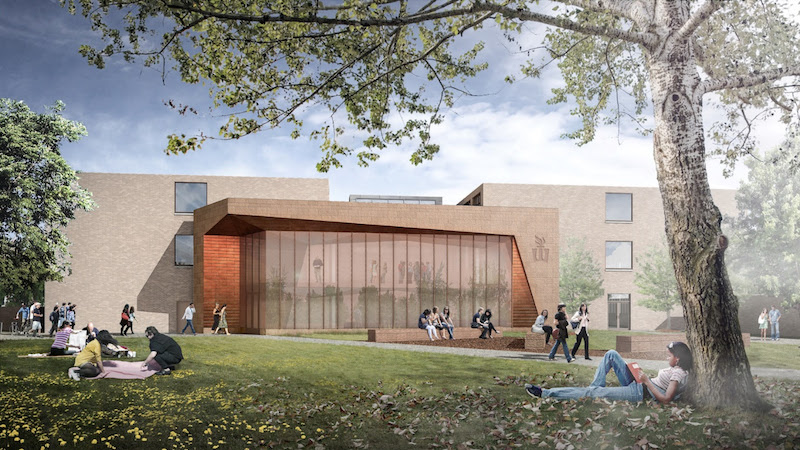A 100,000-sf mini-campus for teacher education is being created from three former school buildings at Winona State University in Winona, Minn. Once completed, the $25.2 million project will create a new section of campus and be home to the university’s College of Education.
Dubbed Education Village, the Leo A Daly-designed project retrofits three separate school buildings from different eras with learning spaces. The design creates learning environments that range from traditional classrooms with blackboards to advanced, technology-enabled active-learning classrooms, STEM labs, maker spaces, and special-education classrooms.
 Rendering courtesy Leo A Daly.
Rendering courtesy Leo A Daly.
The new mini campus includes Wabasha Hall, Wabasha Rec, and Cathedral School. Wabasha Hall is the new main hub of Education Village. It will function as a learning lab and gathering space with a large atrium, experimental classrooms, a child-care center, counselor-education facilities, and breakout spaces for group work.
Wabasha Rec is a former gym that will house physical education and adaptive-sports teaching programs. Cathedral School is a historic schoolhouse originally built in 1929. It will preserve low-tech classrooms relevant to the current spectrum of American schools and house post-graduate teacher-development functions, administrative offices, and the dean’s suite.
 Rendering courtesy Leo A Daly.
Rendering courtesy Leo A Daly.
“By placing a diversity of learning environments into a range of different building contexts, the design helps prepare future teachers for anything they will encounter in professional life,” says Joe Bower, Senior Architect in Leo A Daly’s Minneapolis office, in a release.
Kraus-Anderson is the construction manager for the project, which is expected to be finished in time for the Fall 2019 school semester.
Related Stories
| Dec 17, 2010
Alaskan village school gets a new home
Ayagina’ar Elitnaurvik, a new K-12 school serving the Lower Kuskikwim School District, is now open in Kongiganak, a remote Alaskan village of less than 400 residents. The 34,000-sf, 12-classroom facility replaces one that was threatened by river erosion.
| Dec 17, 2010
New engineering building goes for net-zero energy
A new $90 million, 250,000-sf classroom and laboratory facility with a 450-seat auditorium for the College of Electrical and Computer Engineering at the University of Illinois at Urbana/Champaign is aiming for LEED Platinum.
| Dec 17, 2010
How to Win More University Projects
University architects representing four prominent institutions of higher learning tell how your firm can get the inside track on major projects.
| Dec 6, 2010
Honeywell survey
Rising energy costs and a tough economic climate have forced the nation’s school districts to defer facility maintenance and delay construction projects, but they have also encouraged districts to pursue green initiatives, according to Honeywell’s second annual “School Energy and Environment Survey.”
| Nov 29, 2010
New Design Concepts for Elementary and Secondary Schools
Hard hit by the economy, new construction in the K-12 sector has slowed considerably over the past year. Yet innovation has continued, along with renovations and expansions. Today, Building Teams are showing a keener focus on sustainable design, as well as ways to improve indoor environmental quality (IEQ), daylighting, and low-maintenance finishes such as flooring.
| Nov 23, 2010
Honeywell's School Energy and Environment Survey: 68% of districts delayed or eliminated improvements because of economy
Results of Honeywell's second annual “School Energy and Environment Survey” reveal that almost 90% of school leaders see a direct link between the quality and performance of school facilities, and student achievement. However, districts face several obstacles when it comes to keeping their buildings up to date and well maintained. For example, 68% of school districts have either delayed or eliminated building improvements in response to the economic downturn.
| Nov 9, 2010
Just how green is that college campus?
The College Sustainability Report Card 2011 evaluated colleges and universities in the U.S. and Canada with the 300 largest endowments—plus 22 others that asked to be included in the GreenReportCard.org study—on nine categories, including climate change, energy use, green building, and investment priorities. More than half (56%) earned a B or better, but 6% got a D. Can you guess which is the greenest of these: UC San Diego, Dickinson College, University of Calgary, and Dartmouth? Hint: The Red Devil has turned green.
| Nov 3, 2010
First of three green labs opens at Iowa State University
Designed by ZGF Architects, in association with OPN Architects, the Biorenewable Research Laboratory on the Ames campus of Iowa State University is the first of three projects completed as part of the school’s Biorenewables Complex. The 71,800-sf LEED Gold project is one of three wings that will make up the 210,000-sf complex.
| Nov 3, 2010
Park’s green education center a lesson in sustainability
The new Cantigny Outdoor Education Center, located within the 500-acre Cantigny Park in Wheaton, Ill., earned LEED Silver. Designed by DLA Architects, the 3,100-sf multipurpose center will serve patrons of the park’s golf courses, museums, and display garden, one of the largest such gardens in the Midwest.
| Nov 3, 2010
Seattle University’s expanded library trying for LEED Gold
Pfeiffer Partners Architects, in collaboration with Mithun Architects, programmed, planned, and designed the $55 million renovation and expansion of Lemieux Library and McGoldrick Learning Commons at Seattle University. The LEED-Gold-designed facility’s green features include daylighting, sustainable and recycled materials, and a rain garden.














